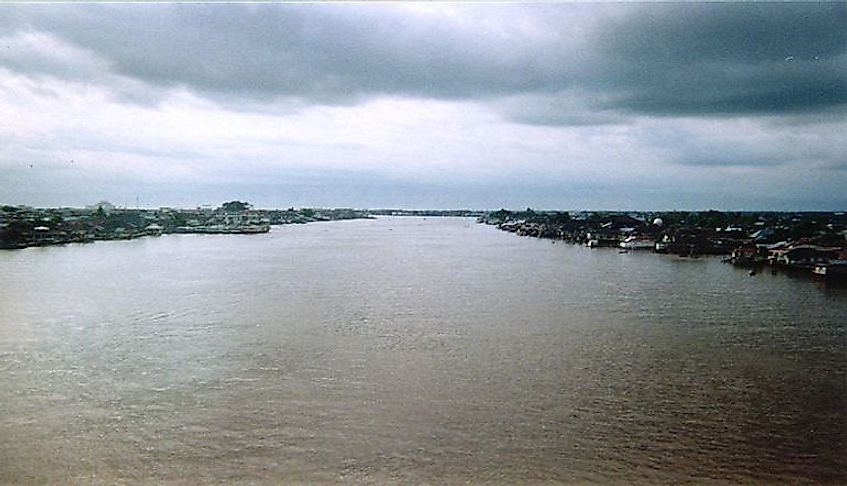Longest Rivers In Indonesia

The majority of Indonesia’s population lives near water, both on the coast or along rivers and lake shores. Indonesia's major rivers do not compare in size or scope to the Mekong or the Yangtze in mainland Asia, but its rivers still play a major role in the country's economy and culture. Four of Indonesia's longest rivers can be found in the Kalimantan provinces on the island of Borneo: Mahakam, Barito, Kahayan, and Kapuas, which at 710 miles long is Indonesia's longest river. Papua New Guinea boasts the second longest river, the Sepik, which is 700 miles long. Other major rivers on the island include the Fly, Mamberamo, and Pulau. Sumatra's longest rivers are the Musi and Batang Hari.
Economic Importance Of Indonesia's Rivers
More than two-thirds of the 300 species of fish identified in the Kapuas river have a high economic value, supporting a thriving fishing industry. The Kapuas River is a major transportation artery connecting the Borneo's center with its western coast: its massive width and depth support intensive cargo and passenger shipping along most of the river's length. Logging and timber rafting also occur along the river.
The Musi river has been dredged to allow large ships to navigate as far as Palembang, a major port city facilitating the export of petroleum, rubber, and coal. The Fly River delta is studded with large islands covered with thick, fertile alluvial soil. Coconut palm, breadfruit, plantain, sago palm, and sugarcane are grown abundantly.
The Mahakam River basin contains numerous lakes, producing annual catches of up to 35,000 metric tons. This area is the second most productive hydrocarbon basin in Indonesia, containing nearly three billion barrels of oil and thirty trillion cubic feet of gas reserves.
Cultural Importance Of These Rivers
Indonesia's rivers provide access to of a number of indigenous tribes that still preserve many traditional ways of life. The Dayak tribes of the Kahayan river region are an Austronesian group which has preserved some of their original culture and religion. Their language, Ma'anyan, is related to the Malagasy language spoken in Madagascar. They practice the Kaharingan religion which combines ancestor worship, animism, and dynamism, and is now considered a form of Hinduism. Many river tribes produce magnificent wood carvings and clay pottery.
Habitat/Biodiversity
When the monthly precipitation exceeds about twelve inches, the Kapuas river overflows its banks, and much of its waters are diverted into lakes. This prevents massive flooding, facilitates fish migration from the river into the lakes for spawning, and drives predators away from the lakes. The area is rich in flora and fauna, with frequent discoveries of new species and extremely complex food chains. One recent remarkable discovery is the Kapuas mud snake, which can spontaneously change its skin color like a chameleon.
The Sepik River basin includes swamplands, tropical rainforests, and mountains. Biologically, its river system is possibly the largest uncontaminated freshwater wetland system in the Asia-Pacific region. Largely an undisturbed environment, there are no major urban settlements, mining or forestry activities in the river catchment area. The Mahakam River is home the Irrawaddy freshwater dolphin, a critically endangered species, and is also an important breeding and resting place for 298 species of bird, including 70 protected and five endemic species.
Territorial Disputes
Japan held the Sepik River area throughout most of World War II. The area was the site of a battle between Japan and Australia in 1945.
Environmental Threats
Logging and mining waste have contributed to the significant pollution of the Fly and Mahakam rivers, particularly during the last decade. A 2015 study found unsafe levels of heavy metals including lead, copper, zinc and cadmium in Mahakam fish. The lower Kayahan river flows through a unique environment of peat swamp forests, which has been significantly damaged by an unsuccessful program to convert a large portion of the area into rice paddies. Future hydroelectric projects also may threaten to submerge many remote and biodiverse river valley areas.
Longest Rivers In Indonesia
| Rank | Longest Rivers in Indonesia | Length |
|---|---|---|
| 1 | Kapuas | 710 miles |
| 2 | Sepik | 700 miles |
| 3 | Fly | 652 miles |
| 4 | Mahakam | 609 miles |
| 5 | Barito | 565 miles |
| 6 | Batang Hari | 497 miles |
| 7 | Musi | 466 miles |
| 8 | Pulau | 419 miles |
| 9 | Mamberamo | 416 miles |
| 10 | Kahayan (Great Dyak) | 373 miles |







